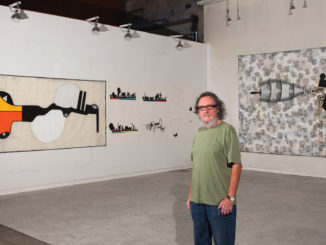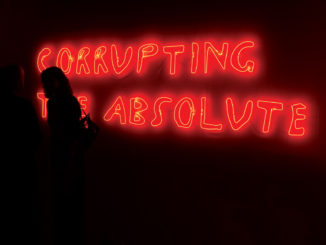 For the past twenty years, the Center for Visual Communication has been at the forefront of bringing experimental and contemporary visual art to South Florida. The CVC has showcased numerous exhibits that have combined bold and daring concepts – mixing live dance with live painting, for example. It emphasizes visual arts and new media, but remains open to those artists who put forward engaging ideas.
For the past twenty years, the Center for Visual Communication has been at the forefront of bringing experimental and contemporary visual art to South Florida. The CVC has showcased numerous exhibits that have combined bold and daring concepts – mixing live dance with live painting, for example. It emphasizes visual arts and new media, but remains open to those artists who put forward engaging ideas.
Its exhibits have run the gamut from pre-World War I German Expressionism to local government campaigns against domestic violence to the photographic Surrealism of renegade photographer-poet Clarence Laughlin. It’s as comfortable aligning itself with New York’s Lincoln Center as it is coordinating with the South Florida Water Management District. The common theme running through all its choices is that of offering every possible expression of the contemporary arts.
“I really like the challenge of putting new things together, presenting things in a way that’s really going to engage minds,” says Barry Fellman, the director. “And it’s very exciting to work with the artists and put together programs that are unique and fresh. The idea of working with creative people, working with artists I extend to my own work, too. So I can present programs in a fresh, new way.”
Originally situated in Coral Gables, the CVC relocated to 541 NW 27th Street, at the west end of Wynwood, in 2007, a time when that area was fairly rough around the edges. It took a leap of faith to decide upon this location. “There were two reasons,” says Fellman. “First, it was time. After over a decade in Coral Gables, it was time to make the move to where the art world was growing. And the other, more practical viewpoint was that the landlord decided to convert the building to hi-rise condos! Although we never believed it would happen, we took that as a little bit of a kick to start us on our journey to Wynwood… we could have stayed in the Gables, but the move turned out to be great for us.”
Great in that the CVC is now a 10,000-square-foot space that can showcase almost any kind of installation or performance. While the CVC’s nominating committee considers virtually any kind of exhibit or artist, there is really only one requirement: having a specific and fresh point of view. Says Fellman, “We try to be really on the edge and show what artists are doing now with a venue to really explore. On the other side of the spectrum, we’re respectful of artists that are of historical importance. And when we do programs related to that, we try to present an in-depth view of important artists.”
Presenting art to South Florida is challenging on any number of levels, but the most basic is that of simply getting patrons to come to the space. Fellman acknowledges that he’s in a battle of sorts when it comes to catching people’s attention and making them aware of all the offerings available, but he prefers the upside.
“Sure, there are challenges here. The weather is so gorgeous and there are so many things available to visitors and also to residents in terms of outdoor activities. So, you can look at this as a challenge or as a reason why we have such a diverse and broad audience.”
The CVC’s patrons are as varied as its programs, especially because many exhibitions offer multiple forms of art. Fellman details one performance comprising live dance and projection and says the audience of about 100 was generally people in their 20s and 30s. Subsequently, while hosting a series of panel discussions at Art Basel on contemporary art in China, the average patron, says Fellman, “was more the established collector. More experienced. So our patrons really vary widely.”
Being a non-profit organization means the CVC is dependent upon donations and fundraising. The present economy has been brutal to art organizations in South Florida, but Fellman spins the perspective around. The CVC produces in conjunction with other art groups which accomplishes a dual purpose: Costs are reduced and fresh ideas are generated.
“One of the things we also get involved in is collaborating with other institutions here. I have found that the audience for dance and visual arts are disparate, and there has not been a large attempt to invite one audience to experience the performance of another artist. So we hosted groups of other visual arts organizations… Although you might think these projects take a lot of money… it is possible to do them without a lot. It matters that we have the help…We don’t rely on projects that require a lot of fundraising.”
Take, for example, one artist who was recently exhibited: Robert Rauschenberg, one of the masters of 20th Century Pop Art. In the presentation that the CVC organized, Rauschenberg In Series A 30 Year Retrospective 1978-2008, were nine major series of complete sets. Included was his last project, The Lotus Series, twelve prints of China in the 1980s, which Rauschenberg completed before his death in May 2008. This was the first time all these pieces were shown together. The exhibit totaled seventy works, has been received with rave reviews in the States and is now traveling to museums in South America.
One current retrospective is Darby Bannard: The Miami Years, which offers some of the bold paintings the Guggenheim Fellow and Miami Master created during his 20 years in South Florida. Bannard, one of the founders of Minimalism, was a major force behind Color Field painting (among other forms) and is considered one of the touchstones of American contemporary art.
Also on exhibit are three newer artists in an installation called Beyond the Daily Life: Guerra de la Paz and Teresa Diehl. Alain Guerra and Neraldo de la Paz work with huge, colorful sculptures; Teresa Diehl showcases two immersive video installations that compare and contrast a frantic world and a quiet, contemplative environment.
In addition, The Adrian Arsht Center for the Performing Arts will offer a new exhibition of fine contemporary art from the Vera and Albert List Collection at Lincoln Center that the CVC will implement and coordinate. All the artists are among the most respected from the past five decades of contemporary art: Helen Frankenthaler, Chuck Close, Elizabeth Murray and Rauschenberg are included. Fellman believes that “It is our vision and goal that visual arts become part of the experience visitors can expect on an ongoing basis at the Arsht Center.”
Fellman is particularly proud of coordination between the CVC and various governmental and school organizations. It’s in keeping with his belief that art must be made available to everyone, not just those with the extra time or inclination to stop by a gallery or museum.
“We have collaborated with other South Florida public organizations that are part of county, city and state government. We have produced programs with and for the South Florida Water Management District, the Miami-Dade Public Schools, Miami Dade DERM… Metro Dade Arts in Public Places. We presented an exhibition on the anniversary of the Roe versus Wade decision on civil rights. We presented that exhibition in our space. And also, we brought that to George Washington Carver Middle School. We actually relocated the exhibition for a week from our gallery to the school.”
“We made artwork that gave women information about access to help if they were victims of domestic violence. Bus posters were made, bus stop artwork. And so we had thirty forty-foot-long posters that were riding on the side of Metro buses with phone numbers and photograph images produced by artists. These buses ran all over the place.”
Under the guidance of Barry Fellman and his associates, the CVC fulfills a need in South Florida to offer cutting-edge works from artists, and it chooses from a long list of artists both established and upcoming. The Center for Visual Communication aims to be a complete resource center for traditional medias (painting, printmaking, photography) and new, electronic technologies. Nothing is off-limits save the predictable.
“We hope to continue to do what we’ve been doing with new ideas,” says Fellman, “programs that the community can take advantage of, that might be presented in perhaps larger American cities, more established art organizations. I hope to continue to present programs that have the quality and depth of programs that would engage audiences in other major metropolitan areas.”



Be the first to comment